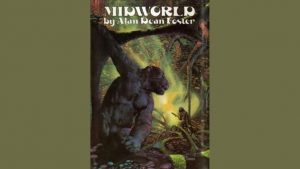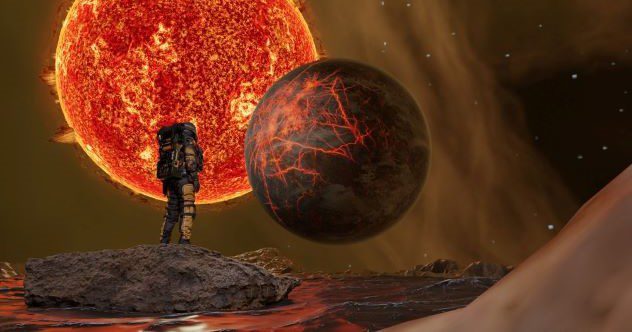The bromide “truth is stranger than fiction” is immortal now, and for science fiction fans, it might seem validated by internet lists of the strangest real planets observable in space. While unusual geographic conditions abound in those real worlds, no truly novel alien biology has yet to be discovered, let alone the thought-provoking and novel civilizations that science fiction authors have imagined. Fictional worlds also have the potential advantage of serving as easily communicated metaphors. So let’s go explore these worlds and the messages they have for us to contemplate.
Related: 10 Lesser-Known Sci-Fi Movies That Are Worth Your Time
10 Riverworld
Riverworld (2010) (Trailer)
Philip Jose Farmer wrote the novel that would be the origin of Riverworld in 1952, but the publisher went bankrupt before it could be released. By 1971, he had honed his craft sufficiently to rework the story into To Your Scattered Bodies Go and, in the process, win his third and final Hugo Award, the science fiction equivalent of the Best Picture winner for the Academy of Motion Picture Arts and Sciences.
To Your Scattered Bodies Go and its three sequels are the story of all 10 billion humans who have lived and died waking up on a new planet. It’s implied this happened because real-world adventurer/protagonist Richard Francis Burton interfered with the stasis condition of regenerating human bodies prior to reanimation, where they revolved around immense energized electric rods while floating in a vacuum. Conditions on Riverworld could pass for heaven, considering everyone is about 20 years old and naked while being dispensed all the food and other sustenance they could ever need through mysterious restocking holes in the ground. Plus, whenever someone dies, they reanimate nearby.
The main geographic feature of the new planet is an enormously long and wide river, which a determined Burton intends to explore to find out why humanity is in this fantastic, totally alien environment. Complicating things is the lack of metal ore, especially for such historical figures as Samuel Clemens, who, in the second novel, intends to build a river boat to explore the river. It’s an extremely dense, indulgent, yet oddly addictive series that has problematically lingered in the imagination of the science fantasy community to the extent that the Syfy Channel produced pilots for it in 2003 and 2010.[1]
9 Flanimal World
Fresh from concluding the global phenomenon The Office for BBC 2 in 2004, Ricky Gervais and illustrator/stand-up comedian Rob Steen published a children’s wildlife book parody called Flanimals. The series would ultimately stretch four entries and begin production for a feature film adaptation by Illumination in 2009. About the most that ever came of this were clips for the ITV production.
The unifying theme of Flanimals is absurdist, maladaptive biological traits for creatures with a planet of their own that somehow came into being and thrived sufficiently to be documented and given Latin names. Many are senselessly violent (Grundits), with others practically helpless (Coddleflops and Puddloflajs, often victims of the Grundits).
A typical example is the Plamglotis, which has no legs, so it swallows its hands and arms so they can function as legs. However, because its mouth is now full, it cannot eat, which was the whole point of swallowing its arms in the first place. It’s a humorous metaphor for how Gervais claims the existential perspective of the books is that life is pointless. Always a good message for the children.[2]
8 Lithia

In 1959, James Blish’s Hugo-winning novel A Case of Conscience posed a question that was extremely daring for Western readers at the time: What if humanity found an alien civilization living the ideal conception of a religious society, except that their views were purely secular? No belief in a higher power, afterlife, or concept of sin, and with it came notions such as karma. Furthermore, the Lithians are not simian, birdlike, or similar to a species humans generally associate with elegance or transcendence; instead, they are reptilian.
When Jesuit priest/world-class biologist and protagonist Ruiz-Sanchez brings the egg of one back to Earth, it hatches into Egtverchi, a Lithian who is innately disgusted by human civilization yet savvy enough with human psychology to instigate riots. Complicating the moral dilemma for Ruiz-Sanchez is that due to Lithia’s mineral richness, his colleagues are eager to invade Lithia for resource extraction, as its peaceful nature leaves it ripe for invasion.
Having set up such an intriguing, morally loaded premise for his story, Blish settles on a conclusion that probably wouldn’t make it past the editorial process today. Ruiz-Sanchez concludes that Lithia, the peaceful, kind, but nonreligious planet, must have been created by Satan to trick Earth’s religious adherents and resolves to perform a planet-wide exorcism on it.
It’s left ambiguous whether his ritual destroys Lithia in a bewildering validation of his religion or if reckless mining practices do. The only way this is a morally defensible conclusion, as reviewer Alex Howe noted, is to reconsider that the Lithians are too perfect to have emerged naturally and thus can only ever exist as an imagined ideal that should be put out of the reader’s mind, for which the exorcism ritual is also a metaphor.[3]
7 Aura
Planet of the Vampires Trailer (1965) – Mario Bava
One of the beauties of science fiction is how more intellectual, prestigious work sits right alongside the most lowbrow work in terms of influence and imagination. So it is that Mario Bava’s 1965 film Planet of the Vampires, a movie with as inauspicious a title as any film could be given. Bava himself poked fun at the cheapness of the production, saying the planet was made with “two plastic rocks” and that his method of obscuring that was “I filled the set with smoke.”
Yet the movie achieved a lingering level of popularity where such critical darlings as Nicholas Winding Refn was quoted in Variety as saying that the Alien series, from the original 1979 film through 2012’s Prometheus, was heavily influenced by this film.
When two human-piloted ships, the Argos and the Galliot, attempt to land on the unexplored planet of Aura, they crash some distance apart. The crew of the Argos almost kill each other because they’ve been possessed by entities unknown. When their crew arrives at the wreck of the Galliot, they find that the other crew was less fortunate when they were possessed by the same entities, for all hands are dead.
After burying the corpses, the Argos crew is in for the shock of seeing the bodies reanimated, and Argos crew members are found dead for good shortly after. Stranded, the Argos crew explores the planet and finds a crashed alien planet with the skeletons of monstrous aliens, who, it turns out, were also tricked into landing on Aura so that the natives could take control of them.
Undeniably, there are certain hurdles to being taken seriously today. For example, the spacesuits the Argos crew wears with black leather and yellow accents look like cyberpunk Tron cosplayers. Nevertheless, for its time, the notion of a planet of ghosts that takes over human minds was unique among science fiction, especially among science fiction films.[4]
6 Midworld

Alan Dean Foster is unquestionably best known for writing novelizations and story treatments for the Star Wars and Star Trek franchises since the 1970s. As far as his original work goes, in 2020, he said that the original story he’d most like to see adapted is his 1975 novel of the eponymous planet, the fourth entry in a series called Humanx Commonwealth.
Midworld is uniquely teeming with life for a science fiction planet—and also uniquely deadly. It’s essentially a planet-wide rainforest, meaning a bewildering array of predatory flora and fauna. It’s divided into three main sections named by natives in ways that reflect the danger well: The Upper Hell (sky), Canopy (treeline), and the Lower Hell (ground).
The foliage is so thick that many who live in the canopy never see the sky. To make matters worse, it’s also home to predators—called “clouders”—whose glowing undersides mimic the sky to mesmerize prey as it drifts down on them through foliage it had cleared out below. In the lower hell, there is such abundant bacteria that if a raft were dropped down there, it would dissolve within hours.
Yet perhaps the most intriguing aspect of the planet is what happened to humans that crashed on the planet centuries before the main action of the novel takes place: They evolved so that even their children have expert-level botanical knowledge to avoid the floral and animal traps that seemingly hide behind every branch of Midworld. They also have a bond from birth with small mammals called furcots that die at the same time as their human counterparts.[5]
5 Lagash
Isaac Asimov’s 1941 classic short story “Nightfall”(reworked with Robert Silverberg into a full novel in 1990) was famously inspired by a discussion with John W. Campbell (author of Who Goes There, the story that became John Carpenter’s The Thing in 1982). The writers were discussing an opinion expressed by Ralph Waldo Emerson, regarding what would happen if humanity only saw stars once a millennium. Lagash is Asimov’s illustration of Campbell’s answer to that question.
Lagash orbits six stars, one consequence of which is that the planet is bathed in so much sunlight that nightfall only occurs every few millennia, which is known as the “long night.” Lagashians are thus innately afraid of darkness and yet enjoy the thrill of being exposed to it under controlled conditions, like an amusement park ride. So when the long night happens, spotty historical records show it always leads to an implosion of civilization. The records are spotty because madness seizes the planet.
However, a group of scientists has secured a bunker with plenty of torchlight to ride out the long night with their sanity intact. Yet when the time of crisis descends, they learn the lesson that those who think they have everything figured out often learn in the worst way.
For anyone curious, astronomer fans of the story have not been able to come up with an orbital model where darkness would be possible for a planet that orbits six suns to experience darkness every two millennia. Observatory of Bordeaux astrophysicist Sean Raymond drew up multiple orbital models. The longest interval between darkness for any of them was two months.[6]
4 0099-4836/010-D
Qntm’s “Valuable Humans in Transit” is pure Existential Horror.
This is, by a wide margin, the least famous planet on this list. Indeed, the author of the 2006 short story “Gorge,” which features this planet, went by his internet alias “qntm” instead of his real name, Sam Hughes, when he commercially published this story for the collection Valuable Humans in Transit and Other Stories. And even with how dark some of the other stories in this collection are, this is easily the bleakest.
0099-4836/010-D is an anomalous planet that is so newly discovered it doesn’t even have a nickname. It has neither atmosphere nor impact craters. Indeed, its gray surface is unnatural in its perfect smoothness in geographic terms. When the Earth flagship Aspera Jaeyo begins scientific exploration, ominous problems immediately arise when the three drones dropped for exploration lose contact almost immediately, consumed by a “gray wave.”
Soon after, the gray wave comes for the fleet of ships themselves and consumes all but the fastest. It seems the gray world was not a regular sphere of rock but a vast collection of gray nanobots that had consumed the entire planet, an example of the “gray goo” scenario coined by Eric Drexler in 1986. They had been contained on the one planet only because they hadn’t learned what space travel was… until the explorers arrived.[7]
3 Matryoshka Brains
What If We Could Build a Mega-Computer in Space?
Most of the planets on this list are purely meant for entertainment and philosophical value; they are not so concerned with scientific rigor. This entry, by contrast, was conceived with more basis in real-world science, though it may sound no less farfetched.
In 1997, Robert J. Bradbury published his proposal for planet-sized quantum computers for calculating problems beyond human, or even humanity’s, capacity. Here, “Matryoshka” refers to familiar matryoshka dolls, which nest inside each other in the same way Bradbury proposes that the processing units of planet-sized computers would need to be arranged for heat and energy distribution purposes. Extrapolating from contemporary trends and neural capacities, he forecasted that such megastructures would be viable by AD 2250.
This notion is still being studied in academic environments. However, as California Institute of Technology Professor Thomas Vidick told Vice in 2020, the interest tends to be more in working out how to fact-check the calculations of these hypothetical computers than drawing up blueprints to send to factories. Still, that means Robert Bradbury is much closer to seeing his imaginary planet become a reality than any of the other authors on this page.[8]
2 Brethren Moons
The Blood Moon|The Convergence Event|Dead Space 3|Ending|4K
Now it’s back to less highbrow science fiction because we’re going to be looking at the Dead Space video game series, which began in 2008. In the 25th century, mankind has achieved wide-ranging interstellar colonization, which runs into disaster when it begins encountering an ancient alien monolith called the black marker. Black markers emit an energy that brings dead tissue back to life and mutates it into hideous, violent monsters called necromorphs.
It turns out that this force is so powerful that it sends waves of reanimating power that wipe out entire planets. Furthermore, all the necromorphs on those planets will eventually form into city-sized hiveminds. From there, many form into entire rogue planet masses that are called both Blood Moons and Brethren Moons. The series has a particularly notable planetoid, but that will not be spoiled here. Belligerent zombie planets are perhaps the most over-the-top idea ever introduced in a mass-market work of science fiction and is surely the most creative answer for the notorious Fermi Paradox.[9]
1 Solaris
SOLARIS (1972) Trailer | Lem 2021: I’ve Seen the Future
To be adapted into a movie is something of an honor for any science fiction/fantasy book. Stanislaw Lem’s 1961 novel has the distinction of being adapted thrice: in 1968, 1972 and 2002. It’s not surprising because the concept of a literal living, conscious world is a captivating one, even if it’s not an evil zombie planet like one of the Brethren Moons.
What sets Lem’s premise apart most compellingly is that the planet Solaris is not just alive and capable of telepathic communication, but it’s something of a scientist. When Kris Kelvin is sent to a station orbiting the planet, Solaris sends him a simulacrum of his recently deceased wife to study his reaction. His reaction includes such violent acts as blowing the arrival from Solaris out an airlock, but Solaris merely replaces her with another, without any violent intent, like running an experiment with a replacement as a control.
It’s a singularly convincing example of science fiction making a world that’s both incomprehensibly alien yet so familiar. Life has a way of throwing us into situations where survival seems almost impossible. Yet, in those moments, both animals and humans find incredible ways to escape the clutches of death. Whether through quick thinking, clever strategies, or sheer willpower, these stories of survival are nothing short of awe-inspiring.[10]
fact checked by
Darci Heikkinen
>>> Read full article>>>
Copyright for syndicated content belongs to the linked Source : Listverse – https://listverse.com/2024/07/28/10-most-imaginative-planets-in-science-fiction-and-fantasy/






























